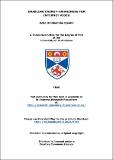Files in this item
Enabling energy-awareness for internet video
Item metadata
| dc.contributor.advisor | Bhatti, Saleem Noel | |
| dc.contributor.author | Ejembi, Oche Omobamibo | |
| dc.coverage.spatial | xiv, 194 p. | en_US |
| dc.date.accessioned | 2016-11-04T16:23:59Z | |
| dc.date.available | 2016-11-04T16:23:59Z | |
| dc.date.issued | 2016-03-30 | |
| dc.identifier.uri | https://hdl.handle.net/10023/9768 | |
| dc.description.abstract | Continuous improvements to the state of the art have made it easier to create, send and receive vast quantities of video over the Internet. Catalysed by these developments, video is now the largest, and fastest growing type of traffic on modern IP networks. In 2015, video was responsible for 70% of all traffic on the Internet, with an compound annual growth rate of 27%. On the other hand, concerns about the growing energy consumption of ICT in general, continue to rise. It is not surprising that there is a significant energy cost associated with these extensive video usage patterns. In this thesis, I examine the energy consumption of typical video configurations during decoding (playback) and encoding through empirical measurements on an experimental test-bed. I then make extrapolations to a global scale to show the opportunity for significant energy savings, achievable by simple modifications to these video configurations. Based on insights gained from these measurements, I propose a novel, energy-aware Quality of Experience (QoE) metric for digital video - the Energy - Video Quality Index (EnVI). Then, I present and evaluate vEQ-benchmark, a benchmarking and measurement tool for the purpose of generating EnVI scores. The tool enables fine-grained resource-usage analyses on video playback systems, and facilitates the creation of statistical models of power usage for these systems. I propose GreenDASH, an energy-aware extension of the existing Dynamic Adaptive Streaming over HTTP standard (DASH). GreenDASH incorporates relevant energy-usage and video quality information into the existing standard. It could enable dynamic, energy-aware adaptation for video in response to energy-usage and user ‘green’ preferences. I also evaluate the subjective perception of such energy-aware, adaptive video streaming by means of a user study featuring 36 participants. I examine how video may be adapted to save energy without a significant impact on the Quality of Experience of these users. In summary, this thesis highlights the significant opportunities for energy savings if Internet users gain an awareness about their energy usage, and presents a technical discussion how this can be achieved by straightforward extensions to the current state of the art. | en_US |
| dc.language.iso | en | en_US |
| dc.publisher | University of St Andrews | |
| dc.rights | Attribution 4.0 International | * |
| dc.rights.uri | http://creativecommons.org/licenses/by/4.0/ | * |
| dc.subject | Internet video | en_US |
| dc.subject | Video | en_US |
| dc.subject | Codecs | en_US |
| dc.subject | MPEG-DASH | en_US |
| dc.subject | DASH | en_US |
| dc.subject | Netflix | en_US |
| dc.subject | Youtube | en_US |
| dc.subject | Green IT | en_US |
| dc.subject.lcc | TK5105.8867E5 | |
| dc.subject.lcsh | Internet videos--Energy conservation | en_US |
| dc.subject.lcsh | Video streaming--Energy conservation | en_US |
| dc.subject.lcsh | HTTP (Computer network protocol) | en_US |
| dc.title | Enabling energy-awareness for internet video | en_US |
| dc.type | Thesis | en_US |
| dc.contributor.sponsor | Scottish Informatics and Computer Science Alliance (SICSA) | en_US |
| dc.type.qualificationlevel | Doctoral | en_US |
| dc.type.qualificationname | PhD Doctor of Philosophy | en_US |
| dc.publisher.institution | The University of St Andrews | en_US |
The following licence files are associated with this item:
This item appears in the following Collection(s)
Except where otherwise noted within the work, this item's licence for re-use is described as Attribution 4.0 International
Items in the St Andrews Research Repository are protected by copyright, with all rights reserved, unless otherwise indicated.


